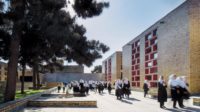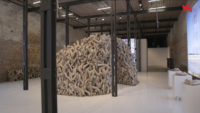Read an update about the school from May, 2022.
An oasis in a crowded city center, the Gohar Khatoon Girls’ School in Mazar-i-Sharif, the capital of Balkh Province in northern Afghanistan, was built under the auspices of two American aid organizations, which brought together a U.S.- based design team, Afghan construction crews, and local government in a unique collaboration to restore and elevate a battered educational infrastructure for young women.
The school—founded more than 50 years ago—has survived decades of war and political upheaval and had been operating in a dilapidated building since the Taliban was defeated in the city in 2001. Four years ago, the Balkh Ministry of Education asked Sahar Education International to help replace it. The nonprofit found a donor in philanthropist Janet Wright Ketcham. She agreed to fund the project, with one stipulation: that she be instrumental in selecting an architect, who would be free to break from the bland standard school plans typically mandated by the ministry.
Sahar executive director Ginna Brelsford says such quickly built, pro-forma schools don’t hold up over time. Ketcham, a patron of architecture and founder of an eponymous foundation that, like Sahar, is devoted to educating Afghan girls and women, wanted a prototype for future schools that melds the latest sustainable methodologies with local building traditions. With a proven track record of school projects for the ministry, the Seattle-based groups got the go-ahead.
The school’s new 43,000-square-foot campus was designed by the late Robert Hull, working pro bono in partnership with University of Washington assistant professor Elizabeth Golden and graduate students in a design studio taught by Golden and Hull. Hull, who died in 2014 and was a founding partner at the Miller Hull Partnership, had designed schools and a national tourism headquarters in Afghanistan during a Peace Corps stint between 1968 and 1972. In the course of the studio, he traveled to the site, while Golden and their students remained at the university, communicating with a Sahar team in Mazar-i-Sharif to explore the needs of local women and to study the region’s culture and climate.
Adhering to international seismic codes, the architects devised a scheme using passive-energy strategies and local materials that, in addition to providing jobs and facilitating maintenance, eliminated the need for an HVAC system, a luxury in Afghanistan. An 18,000-square-foot, two-story classroom building is central to the campus and stands between a sports field to the south and a landscaped court yard to the north—situated to provide privacy for the students and to maximize solar-heat gain. Across the courtyard, a row of similar one-story structures houses additional classrooms, offices, and restrooms, where an adjacent biological treatment system filters wastewater for irrigation.
The concrete-frame structure supports 12-inch-thick brick-infill walls on the buildings’ exterior and throughout the interior that provide substantial thermal mass. Organizing the building to augment natural ventilation, the architects created three seemingly independent volumes linked by a central corridor at grade and bridges above. Inside, the design team inserted glazed double-height “sunspaces” around the stairwells on the south. These warm up in winter and serve as breezeways, along with the corridors, when large steel-framed doors are left open in summer. The designers also developed an operable-fenestration system with a playful arrangement of deeply punched windows on the north and south elevations, and transoms at the top of each volume. Openwork brick screens aid airflow to the classrooms.
The school serves about 3,200 kindergarten-through- 12th-grade students attending two sessions per day. Throughout the design process, the American contingent involved them, the community, religious leaders, and school officials in such decisions as color selection and the development of a computer center—even working with the authorities to hold a national competition for women to create murals for the stairwells.
This inclusion was instrumental in the warm welcome the Gohar Khatoon Girls’ School received when it opened in June 2015. According to Brelsford, who attended the festivities with Hull’s widow and Ketcham, “The girls feel such a sense of empowerment in this building.” Local officials were just as enthusiastic, she adds—so much so that they gave Sahar a green light to initiate a program for young women that addresses alternatives to early marriage.
PeopleArchitect: Robert Hull with the University of Washington Department of Architecture Elizabeth Golden, project architect; Yasaman Esmaili, Christoper Garland, David Miller, project team Engineer: Solaiman Aalahi (structural, civil) Consultants: Michael Gilbride, University of Washington Integrated Design Lab (lighting); PAE Engineering (ventilation); Argent Fabrication (metalwork); Mariam Kamara (systems research) General contractor: Afghanistan American Friendship Foundations - Jason Simmons Client: Sahar/Janet W. Ketcham Foundation Owner: Balkh Province Ministry of Education Size: 43,000 square feet Cost: $885,000 Completion date: June 2015
|
Video CreditsPhotography: Nic Lehoux Directed by: Miriam Sitz Editing: Victor Obidimalor Video by: Soraya Auer Editorial assistance from Linda A. Lentz
|




























Post a comment to this article
Report Abusive Comment